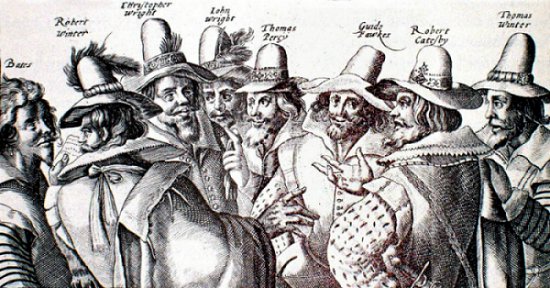The Gunpowder Plot
Today, historian Cathy Patterson asks us to "Remember, remember, the fifth of November. The University of Houston presents this series about the machines that make our civilization run, and the people whose ingenuity created them.
A shadowy group of conspirators, guided by a charismatic leader, seethes with religious fervor and grievance against government. In utmost secrecy, they hatch a plot to bring catastrophic damage upon the centers of authority. They intend, with one dramatic action, to to strike both a symbolic and a very real blow to the halls of power.
A description of Osama bin Laden and the 9/11 plotters? No, this scenario took place 400 years ago in London. November 5, 2005 marks the anniversary of the so-called Gunpowder Plot, and that date is remembered every year in England with Guy Fawkes Day.
The plotters attempted to blow up the members of Lords and Commons, as well as the King, on the State Opening Day of Parliament. Deep religious divisions -- fallout from the Protestant Reformation -- provide the backdrop for this story. The conspirators, extremist Catholics, meant to strike out against the new Protestant king of England, James I. Many had hoped that James might tolerate, or even restore, their religion when he came to the throne in 1603. But instead he continued the anti-Catholic policies of his predecessor, Queen Elizabeth. Fueled by frustration, the Gunpowder plotters looked for a way to turn the tables.
Led by the charismatic Robert Catesby, the plotters hatched a cunning plan. They would tunnel under the houses of parliament, fill their tunnel with explosives, and blast away both the building and all the authority figures inside.
Their plan was ambitious, both as a feat of engineering and of political terrorism. For expertise with explosives and tunneling, they recruited a mercenary from the continental religious wars. He called himself Guido (or Guy) Fawkes. They leased a cellar that abutted the parliament house and began to dig under the chamber where parliament would meet. They had to smuggle out the tailings from their digging and smuggle in fuses, wood, and gunpowder. Fawkes eventually stashed 36 barrels of gunpowder into his tunnel. Seventeenth-century gunpowder can't match modern explosives, but this was more than enough to obliterate the cellar and the meeting-chamber above. Had it worked, the plot would have been devastating.
But things unraveled November 4th. A catholic noble, Lord Monteagle, received a letter warning him not to attend the state opening. He showed it to the king's chief minister, who immediately investigated, discovered Fawkes with the gunpowder in the cellar, and exposed the plot on the 5th. In short order, the plotters were quickly hunted down and either killed or tried for treason. Those tried were tortured, convicted, and sentenced to death by being hung, drawn and quartered.
The English celebrate the plot's discovery on November 5th each year, with fireworks and bonfires. Children make straw effigies of "the Guy" and ask for pennies from passers-by to pay for the fireworks. It's all about fun and noisemaking. But it's also about an attempted act of terrorism that rivals today's worst fears.
I'm Cathy Patterson, at the University of Houston, where we're interested in the way inventive minds work.
A brief history of the Gunpowder Plot can be found here, at the official website of the Parliament of the United Kingdom.
For a very good popular account of the Plot and its context, see A. Fraser, Faith and Treason: the Story of the Gunpowder Plot. (New York: Doubleday, 1996)

A sketch of the gunpowder plotters, published shortly after the attempt